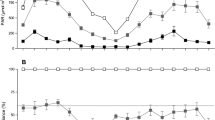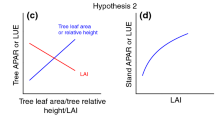Abstract
Competition for light is one of the most essential mechanisms affecting species composition. It has been suggested that similar light acquisition efficiency (Φmass, absorbed photon flux per unit aboveground mass) may contribute to species coexistence in multi-species communities. On the other hand, it is known that traits related with light acquisition vary among functional groups. We studied whether Φmass was similar among species with different functional groups coexisting in moorland communities. We conducted stratified clipping in midsummer when the stand biomass reached a maximum. Light partitioning among species was estimated using a model accounting for both direct and diffuse light. Evergreen species were found to have a significantly lower Φmass than deciduous species, which resulted from their lower absorbed photon flux per unit leaf area and lower specific leaf area. Shrubs had a smaller leaf mass fraction, but their Φmass was not lower than that of herbs because they had a higher leaf position due to the presence of wintering stems. Species with vertical leaves had a higher Φmass than those with horizontal leaves despite vertical leaves being a decided disadvantage in terms of light absorption. This higher Φmass was achieved by a greater leaf height in species with vertical leaves. Our results clearly demonstrate that light acquisition efficiency was different among the functional groups. However, the trend observed is not necessarily the same as that expected based on prior knowledge, suggesting that disadvantages in some traits for light acquisition efficiency are partly compensated for by other traits.


Similar content being viewed by others
References
Aan A, Hallik L, Kull O (2006) Photon flux partitioning among species along a productivity gradient of an herbaceous plant community. J Ecol 94:1143–1155
Anten NPR (1997) Modelling canopy photosynthesis using parameters determined from simple non-destructive measurements. Ecol Res 12:77–88
Anten NPR, Hirose T (1998) Biomass Allocation and light partitioning among dominant and subordinate individuals in Xanthium canadense stands. Ann Bot 82:665–673
Anten NPR, Hirose T (1999) Interspecific differences in above-ground growth patterns result in spatial and temporal partitioning of light among species in a tall-grass meadow. J Ecol 87:583–597
Brady NC, Weil RR (1998) The nature and properties of soils, 12th edn. Macmillan, New York
Cornelissen JHC, Diez PC, Hunt R (1996) Seedling growth, allocation and leaf attributes in a wide range of woody plant species and types. J Ecol 84:755–765
Hikosaka K (2005) Leaf canopy as a dynamic system: ecophysiology and optimality in leaf turnover. Ann Bot 95:521–533
Hikosaka K, Hirose T (1997) Leaf angle as a strategy for light competition: optimal and evolutionarily stable light-extinction coefficient within a leaf canopy. Ecoscience 4:501–507
Hikosaka K, Shigeno A (2009) The role of Rubisco and cell walls for the interspecific variation in photosynthetic capacity. Oecologia 160:443–451
Hikosaka K, Sudoh S, Hirose T (1999) Light acquisition and use by individuals competing in a dense stand of an annual herb, Xanthium canadense. Oecologia 118:388–396
Hikosaka K, Yamano T, Nagashima H, Hirose T (2003) Light-acquisition and use of individuals as influenced by elevated CO2 in even-aged monospecific stands of Chenopodium album. Funct Ecol 17:786–795
Hirose T, Werger MJA (1995) Canopy structure and photon flux partitioning among species in a herbaceous plant community. Ecology 76:466–474
Kikuzawa (1995) The basis for variation in leaf longevity of plants. Vegetation 121:89–100
Koike T (1988) Leaf structure and photosynthetic performance as related to the forest succession of deciduous broad-leaved trees. Plant Species Biol 3:77–87
Koike K, Toshikazu T, Chinzei K, Miyagi T (2005) Regional geomorphology of Japanese Islands, geomorphology of Tohoku region, vol 3 (in Japanese). University of Tokyo Press, Tokyo
Körner C (2003) Alpine plant life functional plant ecology of high mountain ecosystems, 2nd edn. Springer, New York
Matsumoto Y, Oikawa S, Yasumura Y, Hirose T, Hikosaka K (2008) Reproductive yield of individuals competing for light in a dense stand of an annual, Xanthium canadense. Oecologia 157:185–195
Mitsch WJ, Gosselink JG (2007) Wetlands, 4th edn. Wiley, London
Mochida Y, Sato M, Kikuchi T (1997) The vegetation of the south Hakkoda mountains, northern Honshu, Japan. Ecol Rev 23:295–300
Monsi M, Saeki T (1953) Under den Lichtfakton in den Pflanzengeaellschaftn und seine Bedeutung fuer die Stoffproduktion. Jpn J Bot 14:22–52
Muraoka H, Takakura S (1988) Explanatory text of the geological map of the Hakkôda Geother-mal area (in Japanese). Geol Surv Japan, Tsukuba
Nagashima H, Terashima I (1995) Relationships between height, diameter and weight distributions of Chenopodium album plants in stands: effects of dimension and allometry. Ann Bot 75:181–188
Pearcy RW, Muraoka H, Valladares F (2005) Crown architecture in sun and shade environments: assessing function and trade-offs with a three-dimensional simulation model. New Phytol 166:791–800
Poorter L, Kwant R, Hernandez R, Medina E, Werger MJA (2000) Leaf optimal properties in Venezuelan cold forest trees. Tree Physiol 20:519–526
Proctor MCF, Maltby E (1998) Relations between acid atmospheric deposition and the surface pH of some ombrotrophic bogs in Britain. J Ecol 86:329–340
R Development Core Team (2009) R: a language and environment for statistical computing. R Foundation for Statistical Computing, Vienna
Reich PB, Walters MB, Ellsworth DS (1992) Leaf life-span in relation to leaf, plant, and stand characteristics among diverse ecosystems. Ecol Monogr 62:365–392
Ryel RJ, Beyschlag W, Caldwell MM (1993) Foliage orientation and carbon gain in 2 tussock grasses as assessed with a new whole-plant gas-exchage model. Funct Ecol 7:115–124
Schimper AFW (1903) Plant-geography upon a physiological basis. Clarendon Press, Oxford
Selaya NG, Anten NPR, Oomen RJ, Matthies M, Werger MJA (2007) Above-ground biomass investments and light interception of tropical forest trees and lianas early in succession. Ann Bot 99:141–151
Spiegelhalter D, Thomas A, Best N, Lunn D (2003) WinBUGS user manual. MRC Biostatistics Unit, Cambridge
Taneda H, Tateno M (2005) Hydraulic conductivity, photosynthesis and leaf water balance in six evergreen woody species from fall to winter. Tree Physiol 25:299–306
Thomas SC, Weiner J (1989) Growth, death and size distribution change in an Impatiens pallida population. J Ecol 77:524–536
Tsuyuzaki S, Haraguchi A, Kanda F (2004) Effects of scale-dependent factors on herbaceous vegetation patterns in a wetland, northern Japan. Ecol Res 19:349–355
Valladares F, Pearcy RW (1998) The functional ecology of shoot architecture in sun and shade plants of Heteromeles arbutifolia M. Roem., a Californian chaparral shrub. Oecologia 114:1–10
Valladares F, Skillman JB, Pearcy RW (2002) Convergence in light capture efficiencies among tropical forest understory plants with contrasting crown architectures: a case of morphological compensation. Am J Bot 89:1275–1284
van Kuijk M, Anten N, Oomen R, van Bentum D, Werger M (2008) The limited importance of size-asymmetric light competition and growth of pioneer species in early secondary forest succession in Vietnam. Oecologia 157:1–12
Venables WN, Ripley BD (2002) Modern Statistics with S, 4th edn. Springer, New York
Villar R, Merino J (2001) Comparison of leaf construction costs in woody species with differing leaf life-spans in contrasting ecosystems. New Phytol 151:213–226
Werger MJA, Hirose T, During HJ, Heil GW, Hikosaka K, Ito T, Nachinshonhor UG, Nagamatsu D, Shibasaki K, Takatsuki S, van-Rheenen JW, Anten NPR, Marrs RH (2002) Light partitioning among species and species replacement in early successional grasslands. J Veg Sci 13:615–626
Wheeler BD, Proctor MCF (2000) Ecological gradients, subdivisions and terminology of north-west European mires. J Ecol 88:187–203
Wright IJ, Reich PB, Cornelissen JHC, Falster DS, Garnier E, Hikosaka K, Lamont BB, Lee W, Oleksyn J, Osada N, Poorter H, Villar R, Warton DI, Westoby M (2005) Assessing the generality of global leaf trait relationships. New Phytol 166:485–496
Yonebayashi C (1996) Reconstruction of the vegetation at AD 915 at Ohse-yachi Mire, northern Japan, from pollen, present-day vegetation and tephra data. Plant Ecol 125:111–122
Yonebayashi C (2001) Reconstruction of local vegetation in AD 915 at an oligotrophic mire in northern Japan from pollen, present-day vegetation and tephra data. Ecol Res 16:275–288
Yoshida A (2006) Paleo-environmental changes since ca. 13,000 years BP in Tashiro Mire, Aomori Prefecture, northern Japan (in Japanese). Quaternary Res 45:423–434
Acknowledgments
We thank K. Yonekura for advice about species identification and N. Osada, T. T. Makino, K. Ishikawa, E. Okamoto, H. Ono, Y, Suzuki, K. Miyagi, M. Oguro, S. Kato, Y. Matsumoto and K. Namekata for technical assistance. The study was conducted with the permission of the Ministry of the Environment, Aomori Prefecture Government, Aomori City, and the landowner of Tashiro farm. This work was carried out under a JSPS research fellowship awarded to CK, and supported by KAKENHI, the Global Environment Research Fund (F-052 and F-092) by the Ministry of the Environment, Japan, and the Global COE Program j03 (Ecosystem management adapting to global change) by the MEXT to KH.
Author information
Authors and Affiliations
Corresponding author
Additional information
Communicated by Robert Pearcy.
Electronic supplementary material
Below is the link to the electronic supplementary material.
Rights and permissions
About this article
Cite this article
Kamiyama, C., Oikawa, S., Kubo, T. et al. Light interception in species with different functional groups coexisting in moorland plant communities. Oecologia 164, 591–599 (2010). https://doi.org/10.1007/s00442-010-1674-5
Received:
Accepted:
Published:
Issue Date:
DOI: https://doi.org/10.1007/s00442-010-1674-5




